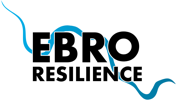Important new developments in the LIFE Ebro Resilience P1 project that starts the adaptation works to flood risk in agricultural areas in the Osera de Ebro – Fuentes de Ebro section (Zaragoza). The intervention was selected by the LIFE Program as a pilot proposal as it is a novel proposal that will serve as a reference for other European basins with similar problems. In total, the overall benefit in the section will be the adaptation of 350 hectares of farms and the recovery of 20 hectares as a space for the river, reducing narrowing.
The works have started with Phase 1 of the “Improvement of flood resilience in the Ebro River, as it passes through Osera de Ebro and Fuentes de Ebro, in Zaragoza”, with a budget of 3 million euros.
The main action consists of the recovery of the fluvial space to solve the narrowing of the river at two points, the mejana del Conde and the meander of Aguilar. By eliminating two sections of the existing flood defense dykes and rebuilding them further away from the riverbed, the river will be able to flow in this recovered space without causing flooding.

Specifically, the works are:
- Removal of the dike (1,020 meters) in the mejana del Conde and construction with the same materials, for a more sustainable intervention, of a new defense further away from the Ebro (998 meters). This action requires the removal of an existing fruit tree plantation on part of the land to be recovered.
- Removal of the dike (2,035 meters) in the Aguilar meander and construction with the same materials, for a more sustainable intervention, of a new defense further away from the Ebro (1,598 meters).
- Removal of invasive species to restore riparian vegetation, mainly 1.3 hectares of common reed, the main invasive exotic species in the area.
- Replacement of affected services: roads affected by traffic, sections of affected irrigation ditch, modification of electric pumping line, relocation of a filtering station, adaptation of a pumping house.
Like all the actions of the LIFE Ebro Resilience P1 Project, these works are the result of administrative coordination and the outcome of a process of social participation with stakeholders in this section.
The interventions described above, which have been agreed with the Town Councils of Fuentes de Ebro and Osera de Ebro and with the Irrigation Community of the Huerta del Ebro (where the intervention lands are located) are executed by TRAGSA (public company partner of the Project), under the direction of the Hydrographic Confederation of the Ebro and, once concluded, the Government of Aragon will carry out the environmental restoration of the recovered lands to enhance the restoration of the area as a riparian undergrowth.

Lateral flow buffer zones
Phase 2, which is nearing completion and will start soon, includes the most innovative intervention, the creation of lateral flow buffer zones.
The project defines a succession of temporary flooding areas, 14 in total, which will compartmentalize the arable area in cells that will be divided into will be pre-flooded in a controlled manner during flood episodes. This will generate water cushions that will minimize damage to farms and infrastructures, mainly for irrigation.
Temporary flood areas have already been tested in other areas of the middle reach, demonstrating their effectiveness in reducing impacts on cultivated land and in protecting infrastructure, and the novel approach is the creation of a chain of such areas, amplifying their positive effect.
Together with these two phases, in the Osera – Fuentes section, another LIFE Ebro Resilience P1 intervention is also being carried out by the Government of Aragon, the adaptation of the irrigation system of the Huerta del Ebro Irrigation Community (Fuentes de Ebro). This action, which is already in its second phase of works, consists of the replacement of an existing irrigation ditch with a new underground pipe further away from the riverbed. This will reduce the impact and the cuts that occurred when the defenses were breached.
Stakeholder participation
The LIFE Ebro Resilience P1 project has public participation as one of its main lines of action and therefore all the interventions of the Osera – Fuentes section have gone through a process with the interested parties.
The deliberative process started in 2021 and intensified at the end of 2022 with the creation of a stable participation group between technicians, municipal representatives and the Irrigation Community.
In addition, other actions have been carried out such as field visits, guided tours with stakeholders and the general population, a public session on buffer zones and field visits to explain in the field the so-calledlateral flow buffer zones for owners or lessees of plots bordering roads or irrigation infrastructure.
LIFE Project
The LIFE Ebro Resilience P1 Project (LIFE20 ENV/ES/00327), approved by the European Commission in the LIFE 2020 call, covers three autonomous communities (La Rioja, Navarra and Aragón), has a duration of 6 years and a total budget of 13,310,350 €, with 55% European funding.
This project is also an example of institutional coordination and cooperation in the intervention section, its partners being the Ministry for Ecological Transition and Demographic Challenge (MITECO), through its companies TRAGSA and TRAGSATEC; the Ebro Hydrographic Confederation; the Government of La Rioja; the Government of Navarra, through Gestión Ambiental de Navarra, S.A. (GAN-NIK); the Government of Aragón and the Aragonese Water Institute.

